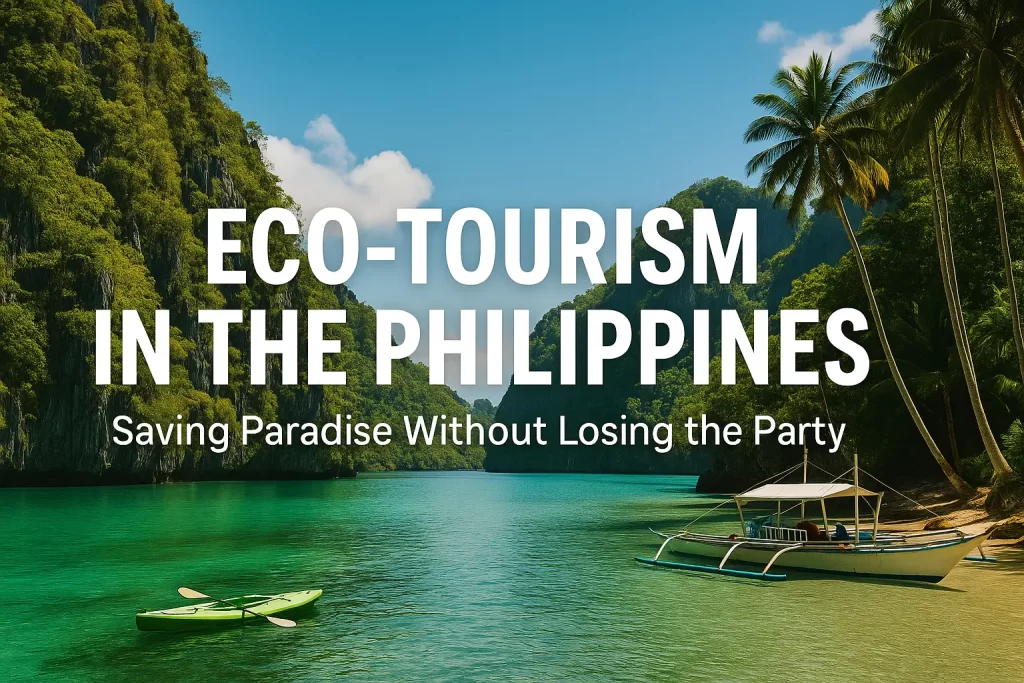
Introduction to Eco-Tourism – It’s Not Just Hugging Trees
What is Eco-Tourism, anyway?
So, what is eco-tourism in the Philippines really about? It’s not just hugging trees or befriending turtles (though, those are definite perks). It’s a growing movement in sustainable travel where tourists aim to minimize their environmental impact while exploring jaw-dropping locations like Palawan, Siargao, and Bohol.
In simpler terms, eco-tourism means traveling responsibly. It’s all about experiencing the Philippines’ natural beauty while ensuring it stays beautiful for generations of sun-seekers and flip-flop adventurers. From coral reef conservation to community-based tourism, this is your ticket to being a globetrotter and a do-gooder. Boom—vacation with a cause.
Why the Philippines is a Natural Playground for Eco-Adventures
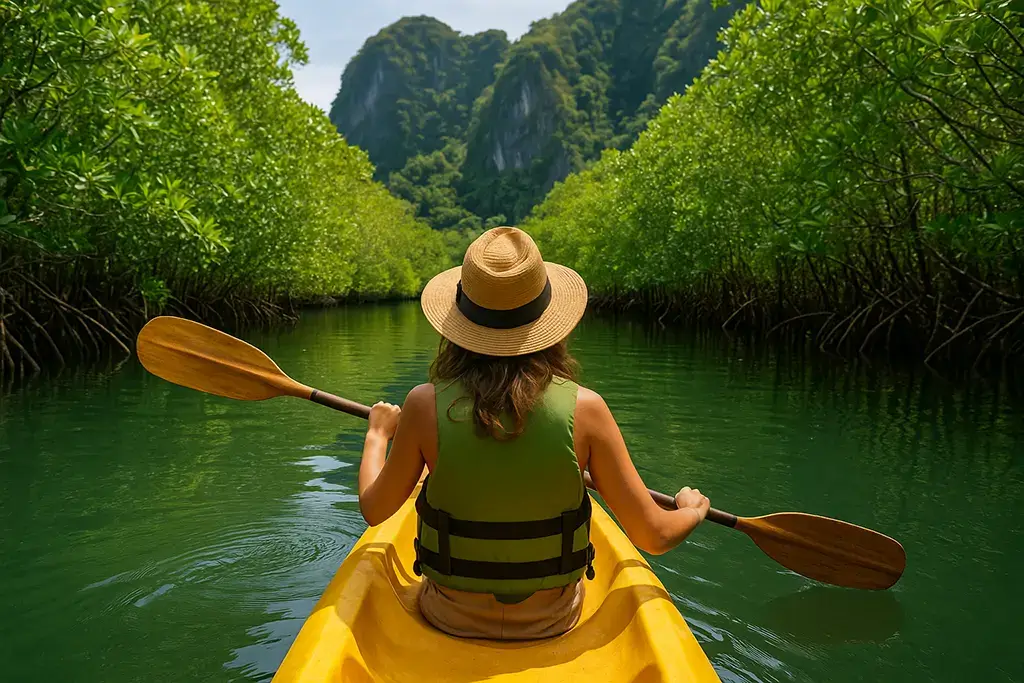
Why has eco-friendly travel in the Philippines become such a big deal? Because this archipelago of 7,641 islands is nature’s overachiever. With its location in the Coral Triangle (aka the “Amazon of the Seas”), the Philippines is home to world-renowned marine sanctuaries, lush forests, volcanoes, and biodiversity that would make David Attenborough cry tears of joy.
The best part? The country is teeming with eco-tourism destinations just waiting for responsible travelers to explore them. Whether you’re swimming with whale sharks in Donsol, volunteering for a mangrove replanting project in Palawan, or snorkeling over a coral reef restoration zone in Apo Island, you’re contributing to something bigger than your tan lines.
The Philippine Islands: Nature’s Overachievers
A Biodiversity Buffet You Can’t Resist
When it comes to biodiversity in the Philippines, this country doesn’t just bring a salad—it brings a full buffet. With over 52,000 known species (half of which are found only here), the Philippines is like nature’s VIP club. Whether you’re chasing butterflies in Bohol or spotting rare birds in Samar, nature-based experiences in this country are everywhere you look.

From the critically endangered Philippine eagle (basically a feathered linebacker) to neon-colored nudibranchs that look like they escaped a rave, this is your dream destination for eco-adventure holidays. Add in untouched landscapes, cascading waterfalls, and wildlife sanctuaries—you’ll run out of SD card space before you run out of things to see.
Additionally, by exploring these biodiverse spots, you’re supporting conservation tourism in the Philippines, which helps fund wildlife protection efforts and local community development initiatives.
The Real Deal on Coral Reefs and Marine Sanctuaries
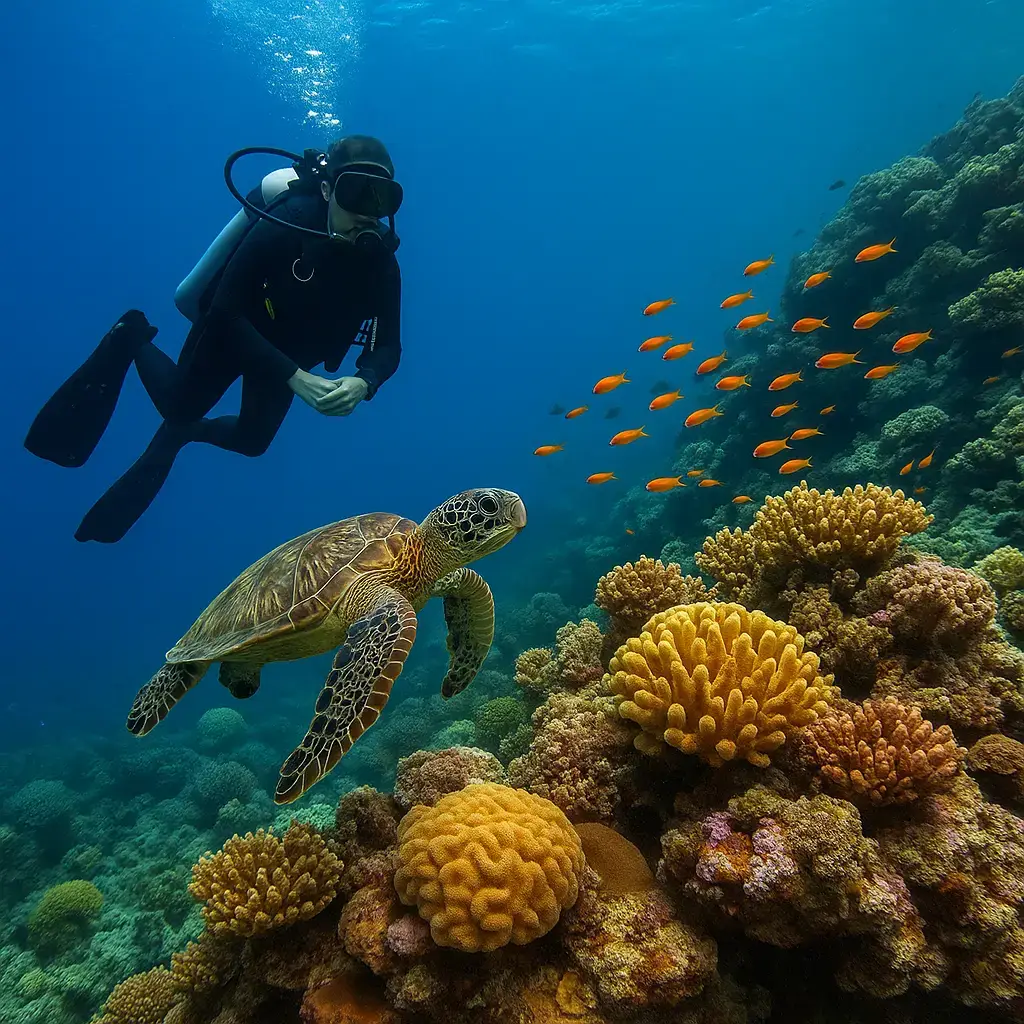
Let’s dive—literally—into one of the country’s crown jewels: its coral reef systems. With over 25,000 square kilometers of coral, the Philippines is a prime spot for sustainable diving and eco-friendly snorkeling. Places like Tubbataha Reefs Natural Park and Apo Island marine sanctuary are not just photogenic—they’re biosphere celebrities protected by both science nerds and ocean lovers alike.
And they’re fragile. Like, emotionally fragile. One careless fin-kick, and it’s like smashing a 500-year-old piece of art. That’s why responsible tour operators are stepping in with strict rules, reef-safe sunscreen mandates, and dive briefings that could rival college biology lectures.
When you dive or snorkel here with certified eco-tour operators, you’re helping fund marine conservation in the Philippines, keeping Nemo and friends safe from the dark side of tourism.
Top Eco-Tourism Spots That Will Blow Your Flip-Flops Off
Palawan – The Poster Child of Sustainable Paradise
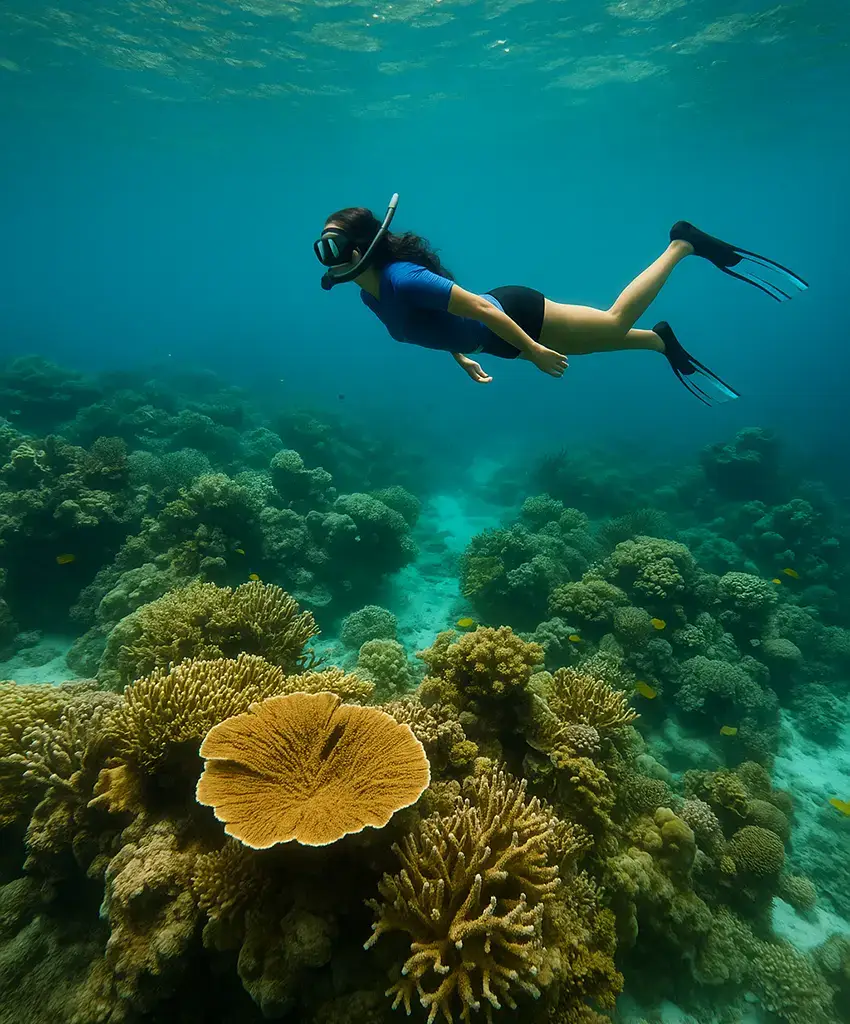
Ah, Palawan. The Beyoncé of eco-tourism destinations in the Philippines. It’s the go-to island for travelers craving postcard perfection and a conscience. Known for its crystal-clear lagoons, dramatic limestone cliffs, and friendly locals, Palawan is at the forefront of sustainable island travel.
In El Nido and Coron, eco-resorts are powered by solar panels, tour boats follow environmentally friendly tourism guidelines, and plastic is about as welcome as a karaoke machine at 2 a.m. You can kayak through mangroves, snorkel responsibly over vibrant coral gardens, or hike trails that support local guides and conservation fees.
This is what green travel in the Philippines should look like: breathtaking views with a sustainable twist. Palawan’s not just showing off—it’s setting the bar.
Bohol – Where Tarsiers and Chocolate Hills Reign
Welcome to Bohol, where the hills resemble desserts and the animals appear like cartoon characters. But don’t let the cuteness fool you—Bohol is serious about community-based tourism in the Philippines.
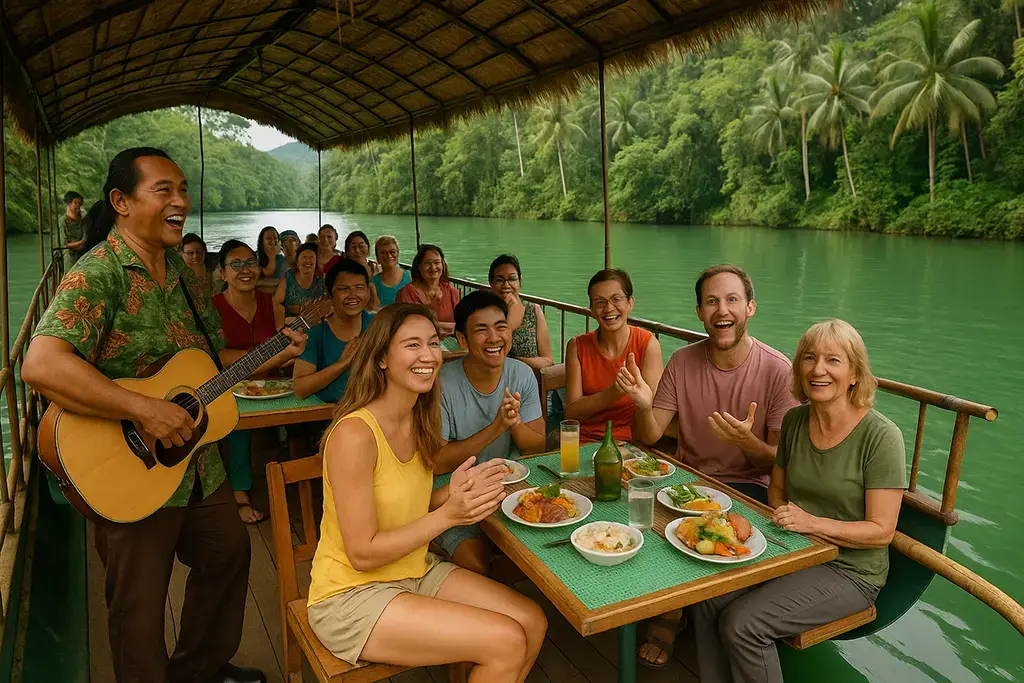
Eco-tours here often include visits to tarsier sanctuaries (yes, they’re real and they’re watching you), river cruises run by local cooperatives, and guided treks that showcase the natural attractions of Bohol. You can also join agro-tourism programs where you’ll learn how to farm like a pro—no tractor required.
By choosing these experiences, you’re directly funding sustainable development in rural areas while also eating your body weight in peanut kisses and calamay. No judgment.
Siargao – Surf, Sustainability, and Sanity
Siargao isn’t just the surfing capital of the Philippines—it’s fast becoming the poster child for responsible tourism in Southeast Asia. This teardrop-shaped island has committed fully to sustainability, from banning single-use plastics to pioneering initiatives that put locals at the heart of the action.
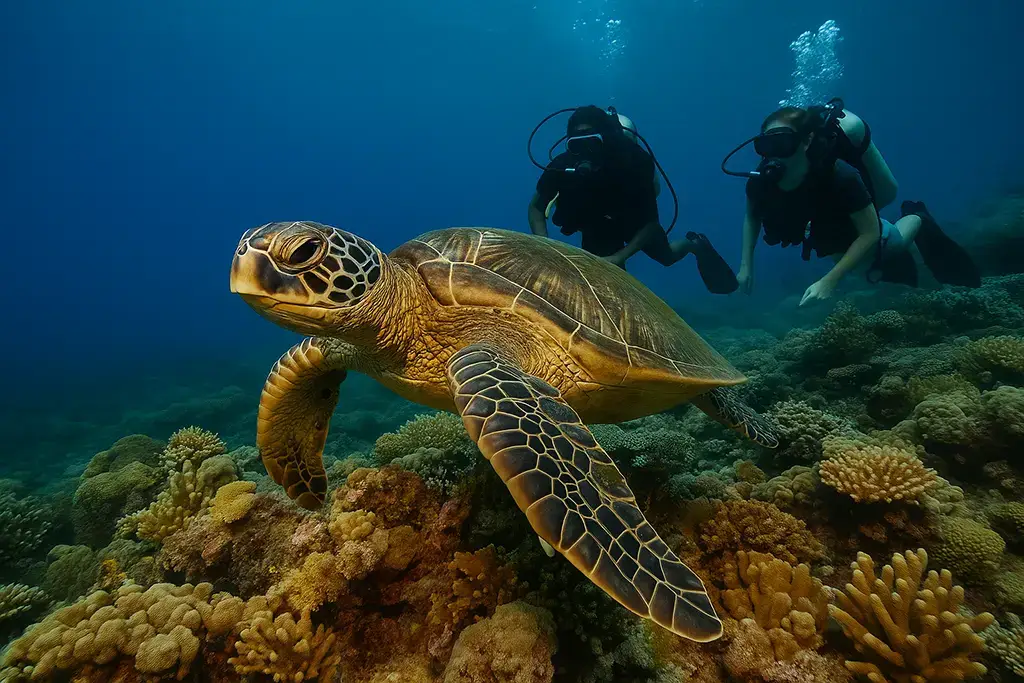
Think eco-hostels made of upcycled wood, surf shops that double as marine education centers, and island tours that include “leave no trace” briefings with every booking. The mangroves here? They’re more protected than the Wi-Fi password at a remote beach café.
Whether you’re surfing Cloud 9 or exploring Sugba Lagoon, Siargao is an excellent example of how eco-friendly tourism and adventure can be great friends.
Eco-Friendly Activities to Get Your Hands Dirty (In a Good Way)
Snorkeling and Diving Without Breaking the Reef
First rule of eco-tourism in the Philippines? Don’t crush the coral, Karen. These reefs aren’t your personal pool float playground; they’re biodiversity hotspots. So, if you plan to snorkel or dive (and you absolutely should), do it responsibly.
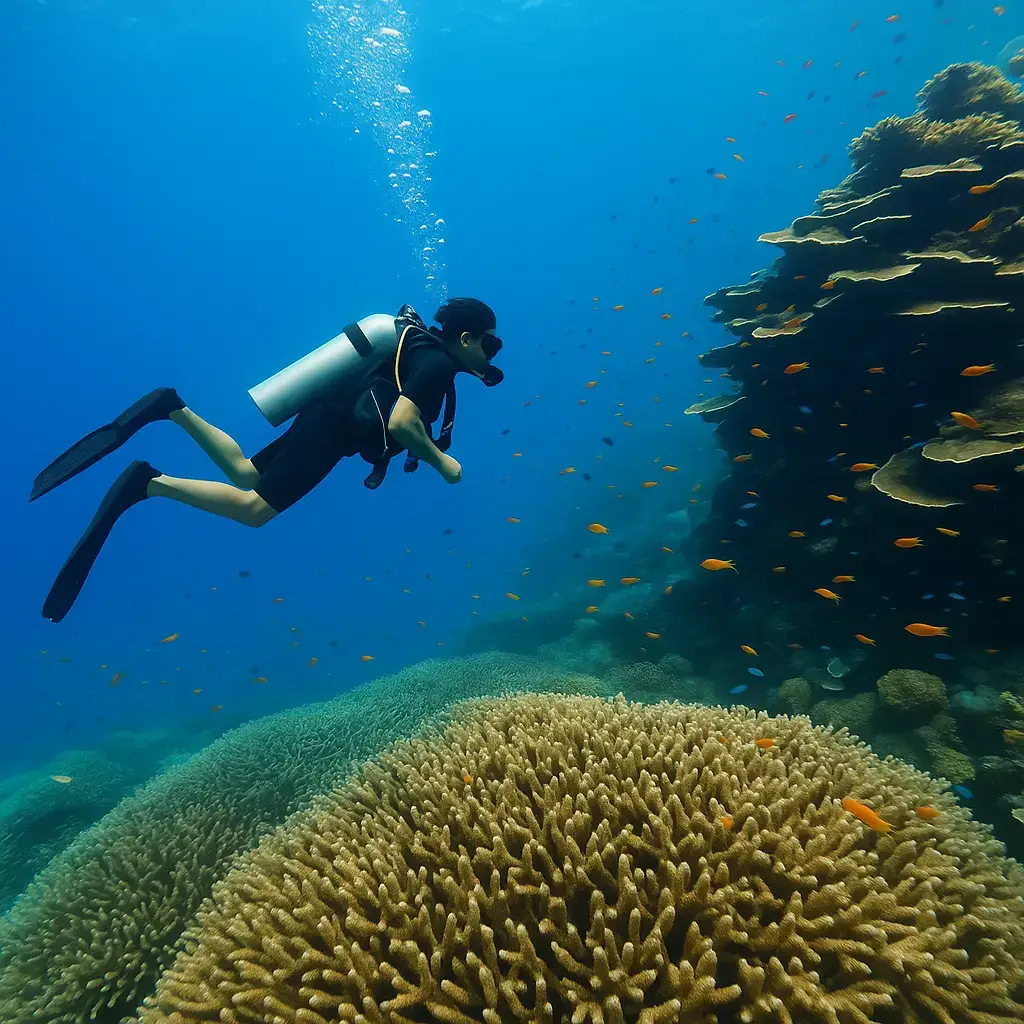
From Apo Island’s marine sanctuary to Balicasag Reef in Bohol, there are endless spots for sustainable diving in the Philippines. Tour operators certified for eco-practices will ensure your underwater selfie adventure doesn’t end in ecological doom. You’ll learn how to keep your fins off the reef, why reef-safe sunscreen isn’t optional, and maybe even spot a turtle who’ll give you the slowest high-five ever.
Even better? Some dive shops now offer volunteer diving programs, where you can help monitor marine life, remove ghost nets, or even plant coral like an oceanic gardener. So yeah, you’re not just diving—you’re diving with purpose.
Hiking, Trekking, and Other Calorie-Burning Joys
If your idea of adventure involves climbing things and sweating in eco-chic hiking boots, the Philippines has got you covered. With everything from volcanoes to rice terraces, you can get your heart rate up and rack up sustainable karma points.
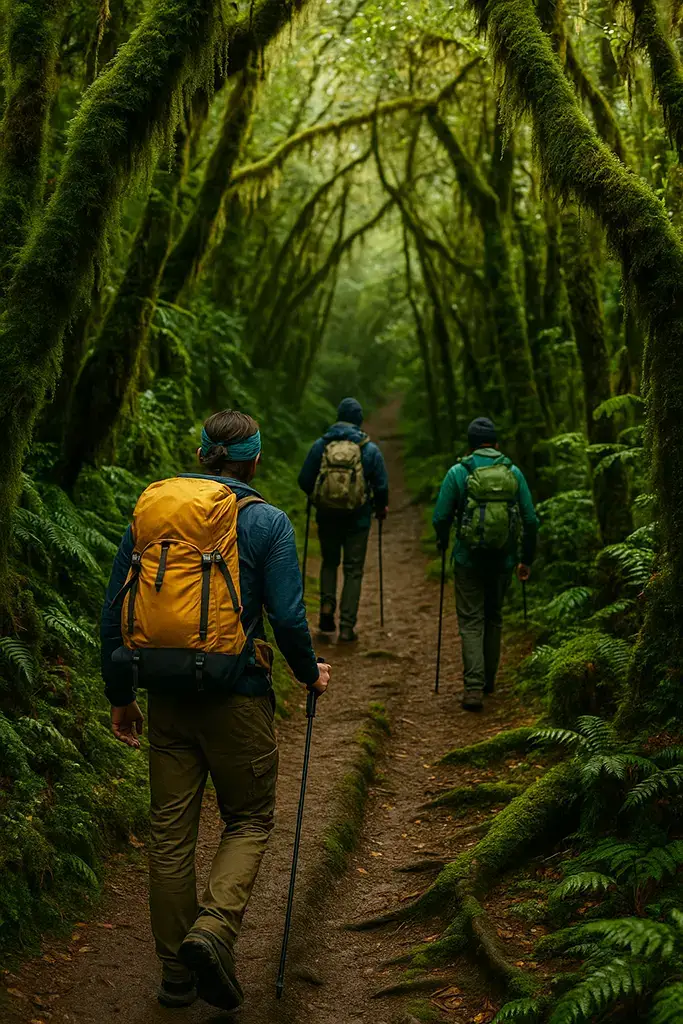
Popular trails, such as Mount Apo, offer not just stunning views but also a chance to engage in eco-trekking in the Philippines. Many are now led by indigenous guides who share knowledge about local flora, fauna, and spiritual traditions. It’s like trekking through a living, breathing nature documentary.
These hikes support rural eco-tourism communities, fund trail maintenance, and help preserve the landscape. Just remember: stay on marked paths, don’t steal rocks (seriously, stop it), and resist the urge to turn every summit into a TikTok dance floor.
Volunteering – Because Giving Back is the New Black
Want to do more than sip buko juice and collect mosquito bites? Try voluntourism in the Philippines—where your vacation can also serve as a meaningful environmental good deed.
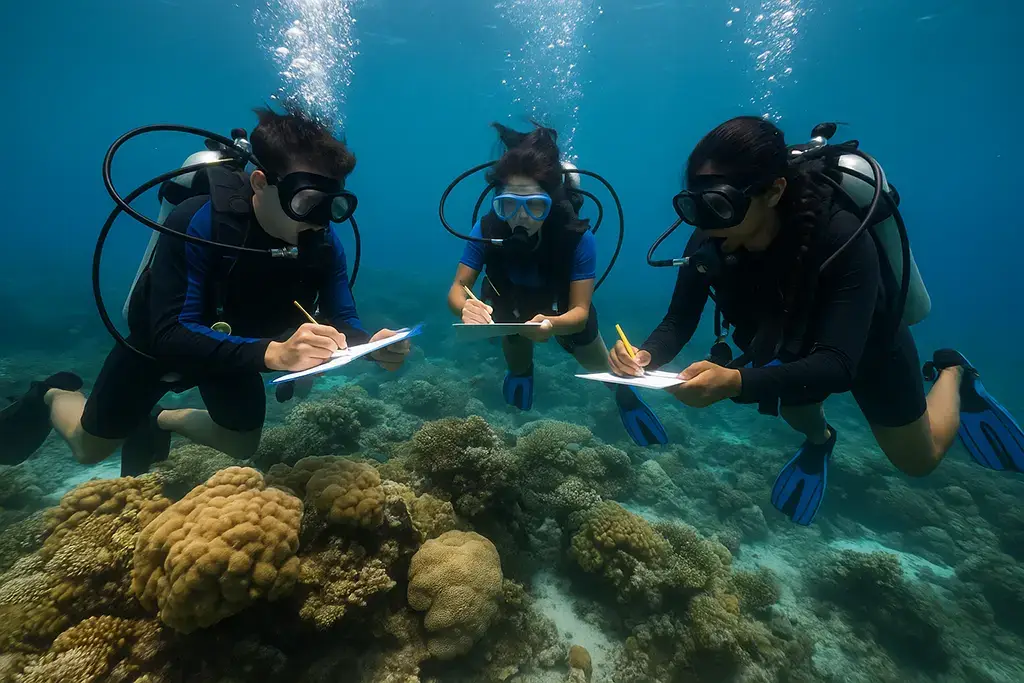
Opportunities abound. You can help with mangrove reforestation projects, join a team, teach eco-awareness to school kids, or clean up beaches that desperately need a break from flip-flop litter. You’ll meet locals, learn a ton, and possibly earn the right to judge other tourists’ sunscreen choices.
Sites like Gawad Kalinga, Marine Wildlife Watch of the Philippines, and Coral Triangle Initiative connect travelers with meaningful work that directly supports sustainable tourism development.
Best part? You’ll come home with stories better than “I drank too much and bought a sarong.”
Staying Green While Living the Dream
Eco-Resorts and Homestays That Don’t Trash the Planet
Want luxury without the landfill? The Philippines has an ever-growing list of eco-resorts and sustainable accommodations that deliver both comfort and conscience.
Check out places like El Nido Resorts in Palawan or Atmosphere Resorts in Dauin—they’re masters of low-impact tourism in the Philippines. We’re talking solar panels, composting toilets, zero single-use plastics, and menus full of locally grown goodness.

For a more intimate experience, consider community-based homestays. You’ll stay with a Filipino family, eat traditional meals, and learn local customs while supporting the very people who keep these ecosystems alive. It’s not just sustainable travel, it’s cultural immersion with rice cakes included.
How to Travel Like a Saint, not a Sinner
Want to be the eco-tourist everyone secretly wants to high-five? Follow these golden rules of :
- BYO (Bring Your Own): water bottle, utensils, and even a metal straw if you’re feeling fancy.
- Eat where the locals eat: not only is it tastier, but it reduces carbon footprints and boosts local economies.
- Use eco-certified tours and transport, because nothing screams irony like jet-skiing through a mangrove forest.
- Leave no trace: including your snack wrappers, emotional baggage, and plastic flip-flops from 2009.
And always—always—respect nature and culture. That includes not climbing ancient trees for a selfie and not mocking the karaoke skills of your tricycle driver. He’s doing his best, okay?
The Ripple Effect – Why Your Visit Matters More Than You Think
Supporting Local Communities Like a Boss
When you opt for community-based tourism in the Philippines, you’re not just getting an authentic experience—you’re directly putting your tourist dollars (or pesos) into the hands of local legends.
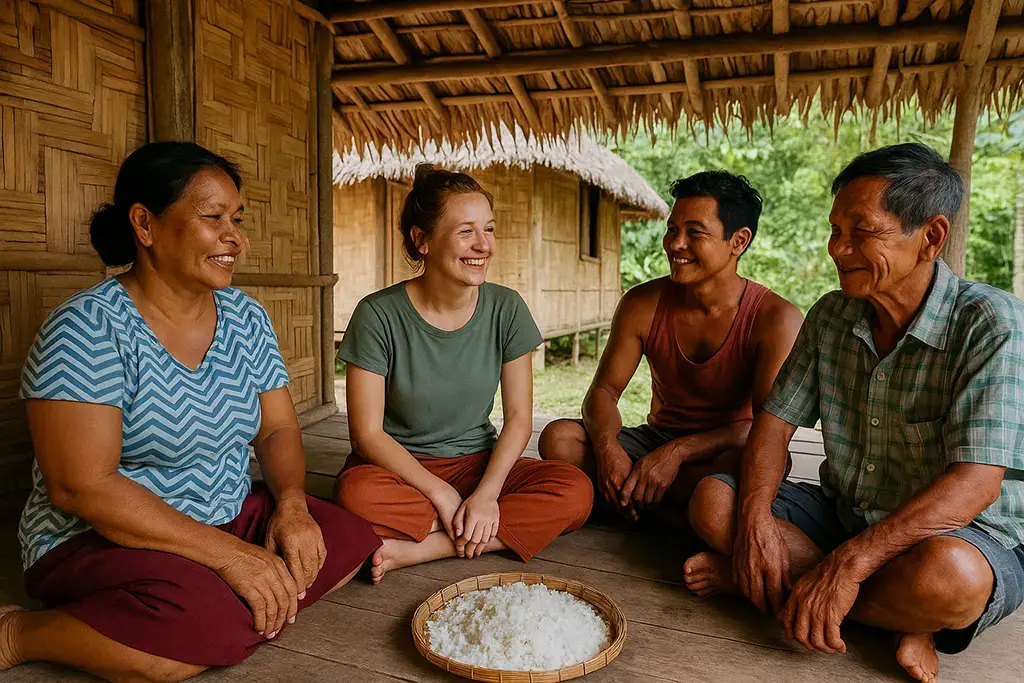
Skip the international chain hotel with its sad continental breakfast and instead book a local option. Hire a local guide who knows which tree the tarsier hangs out in. Buy your woven bags and wooden souvenirs from actual craftspeople, not from airport gift shops with price tags that scream “mass-produced in a factory 800 miles away.”
This is sustainable travel at its best. It empowers communities, preserves indigenous cultures, and helps protect the very environments that eco-tourism aims to showcase. In short, you’re making it rain in the best way possible—ethically, respectfully, and deliciously (seriously, try the pancit canton).
Conservation, One Souvenir at a Time
Shopping? Yes. Shopping smart? Even better. When selecting keepsakes, ensure they align with sustainable tourism practices. Don’t grab that coral bracelet—grab a handwoven banig mat or locally fermented vinegar in a glass bottle. That’s right, your salad dressing game just went eco-elite.
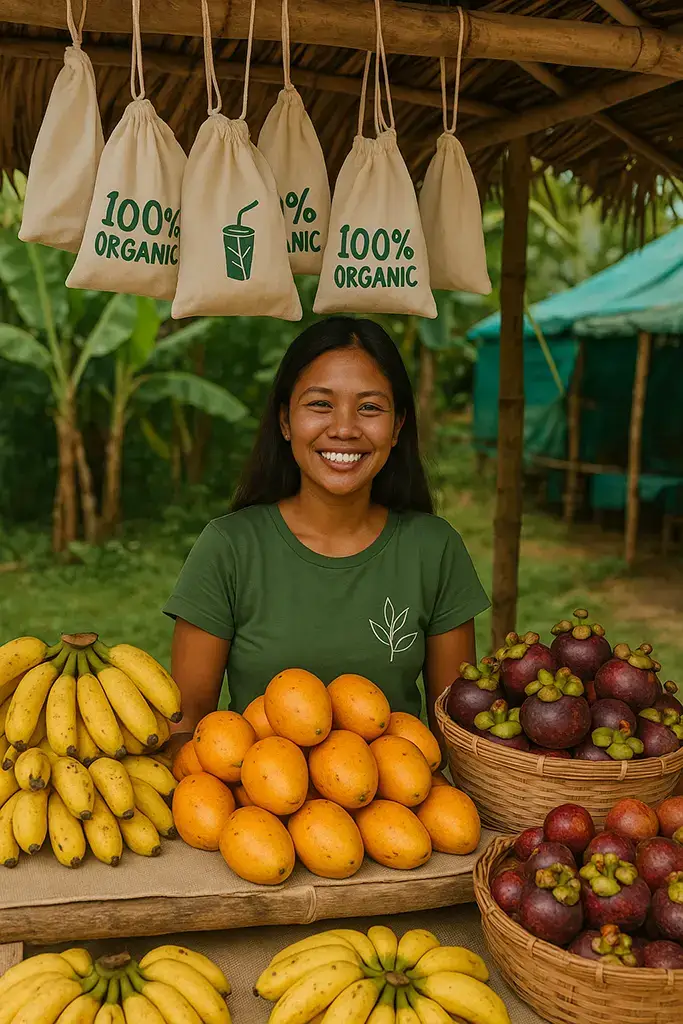
Look for eco-labels, locally made items, and crafts sold through these channels. And always ask questions like: “Was this made sustainably?” or “Are the proceeds supporting local artisans?” or even, “Will this get me stopped at customs?”
By practicing eco-conscious souvenir shopping, you’ll avoid contributing to illegal wildlife trade or overharvesting of natural resources—and you’ll get something way more remarkable than a generic fridge magnet.
Challenges Eco-Tourism Faces in the Philippines
Greenwashing – The Dirty Secret of “Sustainable” Travel
Not all that glitters is green. Some resorts and tours throw around “eco-friendly” like confetti, without backing it up. This is greenwashing, and it’s sneakier than a gecko in your backpack.

Look out for vague claims like “eco-inspired” or “sustainable-ish.” Ask for eco-certifications in the Philippines, such as those from the Department of Tourism or partnerships with groups like WWF or Green Destinations. A truly environmentally friendly resort will proudly show you its practices, from composting toilets to turtle-friendly lighting.
Also, trust online reviews and responsible travel forums. If guests are praising the “eco-lodge” for its endless buffet and hot tubs in the jungle, you may want to double-check that definition of sustainable.
Infrastructure vs. Integrity – The Struggle is Real
Here’s the tea: building roads, airports, and mega-resorts helps tourists access remote locations—but it can also wreck ecosystems faster than a speedboat with no muffler. Balancing infrastructure development with ecological preservation is one of the biggest hurdles in.
Some destinations, like Boracay, have learned the hard way. Others, like Siargao, are trying to get ahead of the curve with strict zoning laws and visitor caps. As a tourist, your role is simple: support destinations and businesses that prioritize sustainable development and protect natural resources, just as you would guard the last Jollibee Chicken Joy.
The Future is Bright (and Bio-Degradable)
Government and NGO Efforts That Deserve a Slow Clap
The Philippine government and local NGOs are doing more than just planting trees—they’re planting policies. The Department of Tourism’s push includes eco-certifications, training programs for local guides, and incentives for eco-resort development.
NGOs such as the Haribon Foundation, Marine Wildlife Watch, and Save Philippine Seas are implementing projects ranging from mangrove restoration to plastic-free festivals. They’re proof that saving the environment isn’t just about preaching—it’s about showing up in rubber boots and getting to work.
You can support these efforts by donating, volunteering, or just not throwing your snack wrapper into the ocean. Every bit helps, and yes, Mother Nature notices.
The Rise of the Conscious Traveler
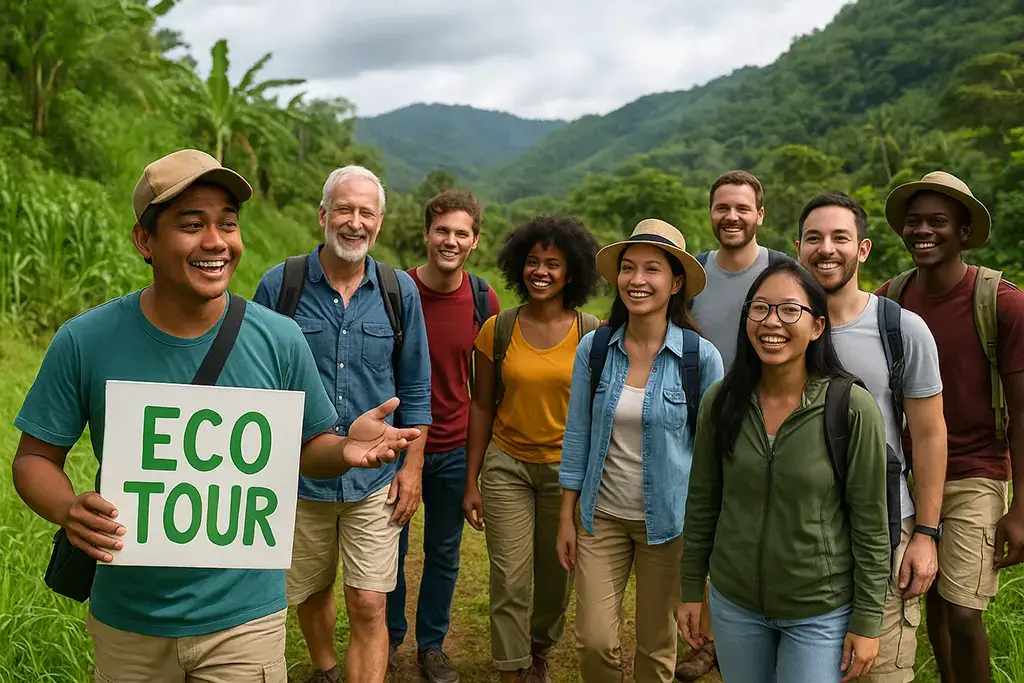
Eco-tourism in the Philippines wouldn’t be trending if it weren’t for the rise of eco-conscious tourists like you. You care, you ask questions, and you pack your shampoo bars. You’re not here for a generic beach vacation—you want meaningful travel experiences in the Philippines that don’t cost the Earth (literally).
Increasingly, travelers are demanding ethical, low-impact tourism, and the industry is responding accordingly. From carbon-neutral travel agencies to zero-waste island tours, the future of travel is green, gorgeous, and guided by people who genuinely care about the planet.
Tips for Being a Rockstar Eco-Tourist
Pack Smart, Travel Smarter
Packing for an eco-friendly vacation in the Philippines isn’t just about rolling your clothes. It’s about being prepared to travel light—and travel right.
- Essentials: Reusable water bottle, eco-bag, bamboo toothbrush, reef-safe sunscreen, and your charming smile.
- Avoid: Over-packing, plastic packaging, and outfits made from mystery synthetics.
- Bonus points: Solar chargers, biodegradable wipes, and a collapsible travel bowl (because snacks).
If it sounds like you’re building a starter kit for a stylish wilderness survivalist, you’re on the right track.
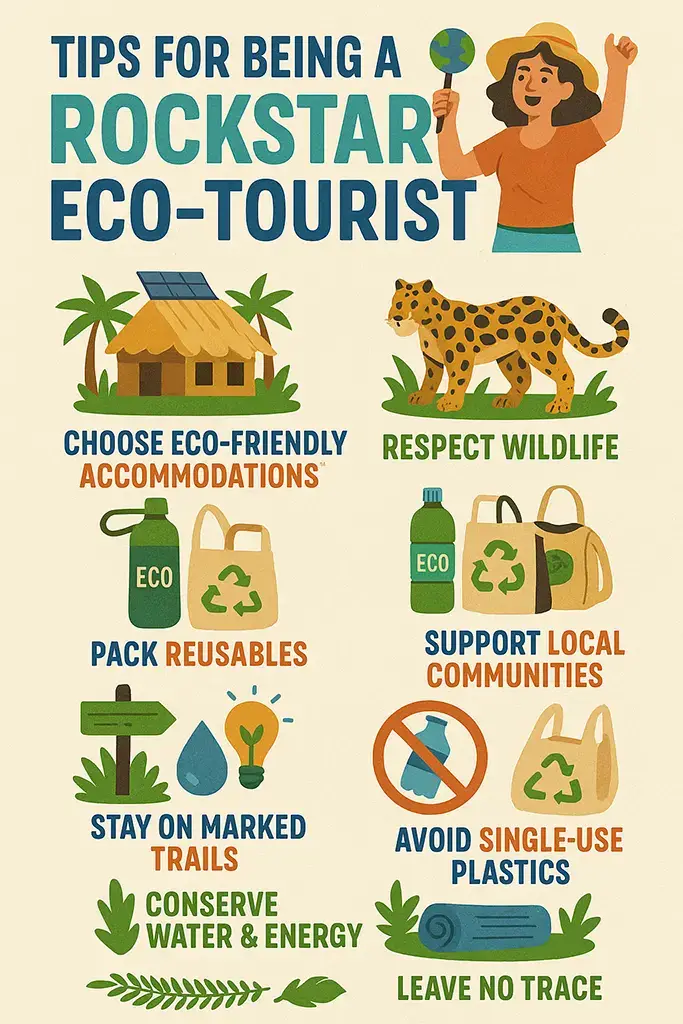
Don’t Be That Tourist – Respect, Rinse, Repeat
Want to blend in like a true responsible traveler in the Philippines? Just follow the three R’s:
- Respect the culture – Learn the phrase “salamat” (thank you) and refrain from touching things in churches unless invited.
- Respect the environment – stay on trails, refrain from collecting shells or sand, and avoid interacting with wildlife (even if it appears harmless).
- Respect yourself – Hydrate, wear sunblock, and try not to challenge a local fisherman to a drinking contest.
Conclusion – Saving Paradise, One Sarong at a Time
So, is eco-tourism in the Philippines worth it? Absolutely. It’s adventure with impact, beauty with brains, and fun with a purpose. Whether you’re surfing responsibly in Siargao, hiking ethically in Banaue, or simply refusing a plastic straw at a seaside café, you’re part of something epic.
This isn’t just about snapping pics for the ’Gram—it’s about helping preserve one of the most beautiful, biodiverse countries on Earth. You get the vacation of your dreams and the bragging rights of a true hero in hiking sandals.
Travel smart. Travel kind. And remember: paradise doesn’t need saving from you—it needs saving with you.
FAQs
What are the best months to travel for eco-tourism in the Philippines?
December to May is the dry season—perfect for eco-adventures without getting caught in a tropical downpour—the best time for diving, hiking, and avoiding the soggy tourist experience.
Is eco-tourism in the Philippines expensive?
Not at all. Many eco-friendly travel options, such as homestays and local tours, are often more affordable and rewarding than luxury resorts. You’ll save money and the planet.
Can I make a difference by traveling sustainably?
100%. Every eco-conscious choice you make—where you stay, what you buy, how you behave—has ripple effects. Be the pebble that starts a wave of awesome.
How can I distinguish between genuine eco-tourism businesses and those engaging in greenwashing?
Look for eco-certifications, transparent sustainability practices, and genuine partnerships with local communities or non-governmental organizations (NGOs). If it smells fishy and it’s not near the ocean, be skeptical.
Is eco-tourism safe in rural areas of the Philippines?
Yes, with basic precautions. Stick to DOT-accredited tours, stay informed, and always respect local customs and traditions. Bonus: Rural areas often have friendlier locals than your morning commute.
Other Articles that may be of Interest
You may also find the following articles interesting.
- First Impressions of the Enigmatic Chocolate Hills of Bohol
- Hidden Gems of Luzon’s Northern Coast
- The Best Fresh Seafood in the Philippines
- Why Expats Love (and Occasionally Panic in) the Philippines
- Diving into the Blue: A Spotlight on the Best Dive Sites in Bohol
Suggestions For Lodging and Travel
Lodging is widely available throughout the Philippines. However, you may want to get some assistance booking tours to some of the Philippines’ attractions. I’ve provided a few local agencies that we’ve found to be very good for setting up tours. For transparency: We may earn a commission when you click on certain links in this article, but this doesn’t influence our editorial standards. We only recommend services that we genuinely believe will enhance your travel experiences. This will not cost you anything, and I can continue to support this site through these links.
Tour and Philippine Travel Assistance
If you are genuinely interested in taking a trip to the Ifugao Rice Terraces, here are a few suggestions for making the necessary arrangements:
- Book your international flights and as many hotels as possible (and necessary) through Expedia.com (it will help me out, and their rates are pretty standard—in fact, I book my trips through Expedia).
- Check out the Guide to the Philippines for tours to the destination. They have the best prices and services.
- Once you know how you want to handle your tour, contact them directly via email or by phone. Their contact info is available on their website. When contacting them, be specific about what you want and ask if they can accommodate a custom booking. I think you’ll find them very willing to help! Remember, you can book transportation, hotels, and specific tours through them. Just be certain of the time requirements.
- Put all the details together on a trip calendar to ensure you address everything. Also, ensure you allow sufficient time for travel and preparation.
- Lastly, please mention this blog to them. I don’t have an affiliate agreement with them, but I would like to!
Local Lodging Assistance
- Guide to the Philippines: This site specializes in tours throughout the Philippines. They seem to have some flexibility in scheduling, and pricing is very competitive. I highly recommend them for booking the local arrangements for a trip like this one! You can book flights and hotels through the Expedia link I’ve provided below.
- Hotel Accommodations: I highly recommend The Manila Hotel for a stay in Manila. I stay here every time I travel to the Philippines! It is centrally located, and many attractions are easily accessible from there. Rizal Park is easily within walking distance. I have provided a search box below for you to use to search for hotels (click on “Stays” at the top) or flights (click on “Flights” at the top). This tool will provide me with an affiliate commission (at no cost to you).
- Kapwa Travel is a travel company focused on the Philippines. It specializes in customizing trips to meet customers’ needs.
- Tourismo Filipino is a well-established company that has operated for over 40 years. It focuses on tailoring tours to meet customers’ needs.
- Tropical Experience Travel Services – Tours of the Philippines: This company offers a range of tour packages, allowing you to tailor your trip to your preferences.
Lastly, we recommend booking international travel flights through established organizations rather than a local travel agent in the Philippines. I recommend Expedia.com (see the box below), the site I use to book my international travel. I have provided a search box below for you to use to search for flights (click on “Flights” at the top) or Hotels (click on “Stays” at the top). This tool will provide me with an affiliate commission (at no cost to you).